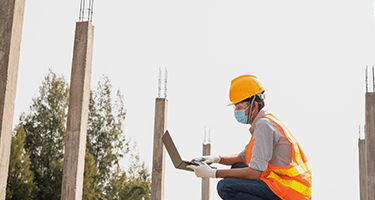The Ultimate Guide to Construction Inspections
When you’re in the process of building a commercial property or a home, you’ll discover that it’s a requisite to conduct regular construction inspections to ascertain that the construction process meets all the quality and safety procedures and standards. However straightforward it may sound, this process can be tasking, given the multiple tasks involved in construction projects. Among other things, you have to coordinate project team members, materials, and equipment and ensure that the contractors are not afflicted by the potential risks and hazards present at the construction site.
This article covers an in-depth look at all aspects of construction inspections to help you have a better grasp of the process and to share how technology can be leveraged to streamline the process.
What is a construction site inspection?
Construction inspection is a contractual duty held by the contractor to assess the progress of a construction project. It entails ensuring that procedures and materials comply with the plan and specifications – monitoring a contractor’s schedule, conducting field testing, and going over the drawings to pick out any errors.
Upon completing the inspection, the building inspector issues the contractor with a construction inspection report. This document acts as evidence that proper tests were conducted to uphold the structural integrity of the building.
6 reasons why construction inspections are important
Below are some of the benefits you’ll accrue from construction site inspections:
#1 Protection against deficiencies in the work
The inspection process ensures that the installation materials and equipment comply with the design plans, contract documents, specifications, and the approved drawings. As such, it offers assurance that the contractor gets materials and quality of work specified, and the building owner gets their money’s worth.
#2 Identification of hazards
Safety should always be the number one priority of a project manager. Construction inspections can help you ensure that the contractors and people who reside around the locality of the construction site are safe from any harm.
The inspections prioritize safety by identifying safe gear for workers to wear, safe roads to transport various materials and equipment, and potential risks and hazards that might occur on the construction site. After all, the construction profession is a dangerous one. The inspections ensure that the necessary precautions are put in place for workers and site safety, so your project flows seamlessly without any instances of work-related injury litigations.
#3 Better communication
Smooth communication between all the parties involved in the project is essential for its efficient completion. An inspection can address a construction team’s communication if the operations aren’t in line with the proper codes and regulations.
In most construction projects, careful coordination of various work processes is essential to limit any possible risks. Inspectors are tasked with communicating with the contractor, anticipating risks, and documenting progress and potential design and construction issues with the owner.
#4 Enhancement of the quality of the construction
Most, if not all, companies strive to offer quality when working on a given project. It not only helps build your reputation but your team members pride in their artistry.
That said, to produce quality work, you need to set high standards, and what better way to do that than through inspections. They will help you identify any code errors or non-adherence to construction regulations.
Producing top-notch work and abiding by the construction regulations will ensure that you present your client with a well-constructed structure.
#5 Better focus on the task at hand
While inspection may be a thorn to construction workers at times, it helps them be alert when working on the project.
Inspections ensure that agents and construction workers focus on the task at hand so that they don’t violate any construction regulations. To add to that, construction workers and agents work more efficiently since they know the pre-established standards they should attain.
#6 Eco-friendly construction
There are environmental regulations that are geared towards ensuring that the construction industry promotes a greener construction environment.
Routine inspections contribute to ensuring that construction companies heed to them. Failure to follow these regulations may lead to construction companies or building owners incurring heavy penalties.
Understanding the different types of construction inspections
Construction is a precarious and hazardous industry encompassing a wide range of activities such as remodeling, repair, and commercial construction.
While performing their tasks, construction workers are subjected to various kinds of harm, including unguarded machinery, electrocution, getting hit by heavy equipment, and falling off rooftops.
Developing a construction inspection checklist addressing the above risks and outlining the various construction regulations your project needs to heed will ensure that you pass your inspection with flying colors when the inspectors come to review your site.
That said, which types of inspection should you perform? Here is an outline of the different types of construction inspections:
Daily site inspections
Just like the name suggests, these inspections are carried out daily.
These inspections assess several activities, including the number of workers on-site in a given day, the types of equipment used, whether the day’s work met quality standards, any unusual happenings on the site, whether there was damage to government property, whether the project is on schedule, among other issues.
Health and safety inspections
One of the areas that the construction inspection covers is the health and safety of workers. Contractors have to ensure that the site meets the health and safety standards set out by Occupational Safety and Health Administration (OSHA).
The health and safety inspections can be conducted externally by a regulating body, internally by the contractor, or through third-party audits. Among the health and safety standards that are checked during this inspection include:
- Asbestos risks
- The soundness of electrical systems
- Provision of welfare services such as handwashing facilities and toilets
- The management of various respiratory risks
- The prevention of unauthorized people from accessing the site
- The structural stability of the construction
- Provision of personal protection equipment (PPE) such as helmets, goggles, or other garments.
- Provision of personal fall protection systems among other fall prevention equipment
- The condition of the vehicles, plant, and other equipment, among other things.
The timing of health and safety inspections should be as frequent as possible and be accompanied by accurate reports and actionable measures.
Quality control inspections
Quality control inspections are those that are geared towards ensuring that construction workers comply with the construction requirements and regulations.
These controls encompass the products and materials, the execution of the project, and the completion of the construction works. Quality control inspections are a way of ensuring that the finished works meet the set standards. It helps refine the work before it’s presented to the client so that if there is anything that doesn’t comply with the standards it’s fixed.
The international standard that governs the construction industry is the ISO 9000 set of standards. It includes reports, technical guides, and specifications on the efficiency of a construction company’s quality management system.
Typically, the principles that dictate quality management in the construction industry are the budget of the project, the scope of the construction project, and the scheduled completion time.
Some of the construction inspections related to quality include checks for equipment and materials, work processes, units, and services planned and designed by the construction company to comply with the quality requirements of the contract. Quality control inspections lead to a monthly quality report that identifies various issues and monitors the project’s progress.
Building regulation compliance inspections
Building inspections are usually conducted by an approved third party or a building control local authority. Depending on details such as the scope of the project, these inspections vary in frequency and number. Generally, the building inspections are required in the following stages of the project:
- Commencement
- Excavation stage (prior to the filling of excavations)
- Foundation stage (before the foundation is covered up)
- When laying the damp proof courses
- Installation of new drains (before covering up)
- When constructing the primary structure
- When installing insulation
- Construction of the roof
- Completion of the project
OSHA inspections
OSHA conducts periodic inspections and consultations to ensure contractor compliance and protect workers. The OSHA inspector will look at procedural problems or physical hazards like equipment lockout procedures, inadequate machine guards, respiratory issues, noise, availability of PPE for construction workers, among other issues.
Among the reasons OSHA may come to inspect your site include workplace fatalities and hospitalizations, imminent danger situations, referrals and complaints concerning potentially hazardous conditions, scheduled inspections, and follow-up inspections.
Depending on the inspection findings, a contractor may receive a report detailing the violations found, what has to be corrected, the duration within which to make the corrections, and the monetary fines for the violations.
Other types of inspections
Some other inspections that contractors should expect include:
- Insurance inspections
- Environmental inspections on pollution (water, smoke, and noise)
- Fire inspections—availability of fire protection systems, fire escapes, and storage of certain materials
- Planning inspections to ascertain whether you complied with planning permissions, obligations, and conditions
- Inspection of the release of finances (by relevant agencies)
- Archaeological inspections (in case of excavations)
- Inspection of street works conducted by highway authorities in the case of road and sewer constructions
Best practices for construction inspections
Here is an outline on some of the best practices to heed for construction inspections:
- Ensure that you have a checklist: Your construction inspection checklist will help you identify any violations of the construction regulations and have them rectified before the inspection.
- Budget: Ensure that all your construction inspection checklists that have monetary dealings reference the project budget. Make sure that you complete the project with the allotted budget. Also, use your inspection to ascertain that every spending meets the budgetary allocations as you move from one phase to the next until the completion of the project.
- Schedule: Remember, your project should not affect your client’s budget. As such, not completing the project in time will make them dissatisfied. Use the inspection to monitor the schedule of your project daily, weekly, and monthly. Also, ensure that you inform the relevant parties of any delays.
- Scope of the project: The inspection process should be led by the defined scope of the project. Ensure that you notify your client of any adjustment to the scope of the project. Also, make sure that you use the construction inspection to confirm that everything is running according to the project’s scope.
- Plan ahead: You can do this by undertaking a pre-task session that allows workers to identify and avoid mishaps.
Benefits of using mobile apps and forms to manage construction inspections
As you probably know, the construction industry has cutthroat competition. As such, you need proper productivity tools to gain a competitive edge.
Given the fast rate at which the construction industry is adopting digital solutions, you cannot afford to lag behind.
Mobile app forms will give your construction business a leg up that you need to stay ahead of your competition. Here are some of the key benefits of mobile forms and apps:
- The improvement of communication between various parties in the construction project: Mobile apps and forms eliminate communication gaps by enabling you to dispatch information to various parties of the project directly via a mobile phone.
- Incorporating photos into documents: Enabling the photo capture feature on your mobile forms app will allow you to add pictures directly into your documents. You can, therefore, better describe construction progress issues and achievements.
- Capturing digital signatures: Mobile app forms allow you and your client to sign and save various documents directly via the program.
- Improved document organization: This app enables you to keep track of paperwork and files so that you always know where to retrieve them from.
- Mobilization of document construction: With this app, you can go with your documents wherever you want without the fear of losing them or being damaged.
Get started with GoCanvas for construction inspections
Are you looking for an easy-to-use mobile forms app that can help improve the operations of your construction company? GoCanvas is your go-to tool for construction inspection reports, checklists, and more. Try out GoCanvas and all its features with a free trial or contact our team to learn more.

Stay in Touch!
About GoCanvas
GoCanvas® is on a mission to simplify inspections and maximize compliance. Our intuitive platform takes care of the administrative tasks, freeing our customers to focus on what truly matters – safeguarding their people, protecting their equipment, and delivering exceptional quality to their customers.
Since 2008, thousands of companies have chosen GoCanvas as their go-to partner for seamless field operations.

Check out even more resources

The Ultimate Guide to Quality Control Inspections
Managing a construction project is a complex and stressful process. Among other things, you have to coordinate project team members, materials, and equipment and ensure that contractors are not afflicted by the potential risks and hazards present at the construction site. That said, quality means different things to different people which is why you should…

Constructions Digital Transformation
Your competition is finding faster ways to capture data and get critical insights from the field into their existing systems. In short, they’re not going bigger, they’re getting smarter. In this 15-minute broadcast on the construction industry’s digital transformation, find out why the trend is to modernize workflows – and how you can stay ahead of the curve…

See how VIP Lighting optimized efficiency with GoCanvas
VIP Lighting is a retail lighting and electrical maintenance business that services over 10,000 retail locations all over Australia and New Zealand. Before GoCanvas, VIP Lighting had two separate systems that were impossible to integrate, leading to inefficiencies. GoCanvas made it easy to integrate their systems into single, centralized platform…